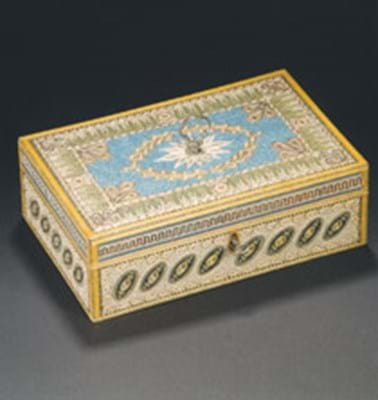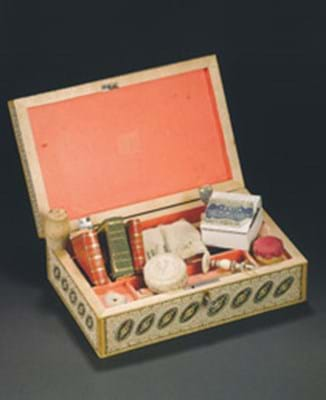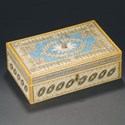The 'whitewood' boxes with raised decorative edge borders would be manufactured by a specialist box maker, leaving recessed panels for the intricate coloured paper rolls to be worked flush by someone with time on their hands.
Quillwork is a relatively common form of tea caddy decoration and less occasionally is seen on workboxes too. But rarely does it survive in the sort of vibrant, unfaded colours that adorned a George III sewing box, 9in (22cm) across, seen at Bonhams Knowle on December 13.
Just occasionally an object like this emerges to remind us that Georgian England was not an era of faded pastel tones and a dozen subtle gradations of brown.
As the accompanying pictures suggest, the lid to this box was a vivid turquoise and its sides set with multicoloured ovals, teardrops and other variant quillwork panels in a variety of colours including black, cream, yellow, green and blue. The interior lined in pink paper includes various sewing accoutrements including three leather-bound 'books' - Poems Vol. I for use as an emery board,Poems Vol. II containing a yellow silk skein holder and double needle flannel, and another in green and gold fitted with two needle flannels.
Both the cut steel axe head handle and the key were original too.
There is, perhaps, good reason why this box has survived in such remarkable condition.
A typed note accompanying it states: This box, which is made of rolled paper, belonged to Mary Earnshaw. She died on the 12th July 1797, in her eighteenth year. It is thought she made the box in 1795. A modern envelope was further inscribed: Mary Earnshaw's box, she had connections with Wakefield.
Research in the parish records has shown there was indeed a Mary Earnshaw in Wakefield and she had a younger sister, Jane, who is thought to have inherited her sister's handiwork after her untimely death.
The outer handmade blue card box that has protected the box for two centuries carries the inscriptions in old ink script Jane Earnshaw, 1816, Lace, and again to the interior J.E. 1816.
Jane doubtless kept it as a memento mori of her sister - accounting for its exceptional condition and no doubt contributing towards the exceptional price it commanded at Knowle, where it sold for a triple-estimate £13,600 (plus 17.5 per cent buyer's premium).
Stunning tribute to a tragic teenager
Like needlework, letter writing and mastering the harpsichord, rolled paperwork or quillwork was deemed a suitable pursuit for a young lady of the 18th century.








